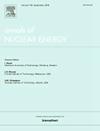利用 NEXUS 对大破裂 LOCA 期间的燃料行为进行全岩心多物理场模拟
IF 1.9
3区 工程技术
Q1 NUCLEAR SCIENCE & TECHNOLOGY
引用次数: 0
摘要
本文章由计算机程序翻译,如有差异,请以英文原文为准。
Core-wide multi-physics simulation of fuel behaviour during large-break LOCA using NEXUS
Large-break loss-of-coolant accidents (LB-LOCAs) are among the most critical scenarios in nuclear power plant safety analysis due to their potential to significantly challenge the integrity of barriers confining radioactive material. This study demonstrates, for the first time, the application of the NEXUS framework to perform detailed, core-wide fuel assessments during a design basis accident. NEXUS integrates RELAP for thermal-hydraulics, PARCS for neutronics and ENIGMA for fuel performance to analyse the thermo-mechanical responses of fuel rods across the reactor core during accident conditions. The analysis, applied to a 1240 MWe/3400 MWth Pressurised Water Reactor (PWR) with Optimized ZIRLO cladding and conventional UO fuel, presents a computationally efficient methodology to capture core-wide fuel behaviour — an area where comprehensive approaches remain scarce in the literature, particularly for metrics beyond peak cladding temperature.
An LB-LOCA scenario, specifically a double-ended guillotine break of a cold leg, was modelled as a design basis accident to evaluate fuel integrity under limiting conditions. Four LB-LOCA cases were simulated to assess the impact of varying power profiles and fuel states on cladding rupture stress and plastic hoop strain increment. Enhanced features in the ENIGMA code, including high-temperature clad creep, oxidation, and failure models, as well as a dynamic phase change model, were employed to facilitate margin-to-failure calculations under LOCA conditions. Results highlight relatively benign outcomes at the beginning of cycle (BOC) compared to more challenging end-of-cycle (EOC) scenarios, primarily driven by variations in rod internal pressures.
Both best-estimate and power conservatism cases were studied to assess fuel performance. The successful demonstration of NEXUS’ capabilities opens avenues for employing best-estimate plus uncertainty (BEPU) methodologies in future evaluations. Given its computational efficiency, this study highlights the NEXUS framework’s ability to balance detailed fuel assessments with reasonable computational demands for design basis accidents.
求助全文
通过发布文献求助,成功后即可免费获取论文全文。
去求助
来源期刊

Annals of Nuclear Energy
工程技术-核科学技术
CiteScore
4.30
自引率
21.10%
发文量
632
审稿时长
7.3 months
期刊介绍:
Annals of Nuclear Energy provides an international medium for the communication of original research, ideas and developments in all areas of the field of nuclear energy science and technology. Its scope embraces nuclear fuel reserves, fuel cycles and cost, materials, processing, system and component technology (fission only), design and optimization, direct conversion of nuclear energy sources, environmental control, reactor physics, heat transfer and fluid dynamics, structural analysis, fuel management, future developments, nuclear fuel and safety, nuclear aerosol, neutron physics, computer technology (both software and hardware), risk assessment, radioactive waste disposal and reactor thermal hydraulics. Papers submitted to Annals need to demonstrate a clear link to nuclear power generation/nuclear engineering. Papers which deal with pure nuclear physics, pure health physics, imaging, or attenuation and shielding properties of concretes and various geological materials are not within the scope of the journal. Also, papers that deal with policy or economics are not within the scope of the journal.
 求助内容:
求助内容: 应助结果提醒方式:
应助结果提醒方式:


